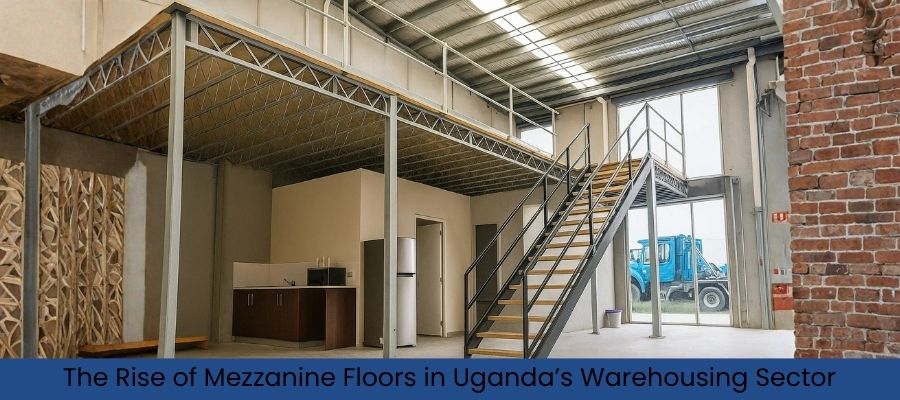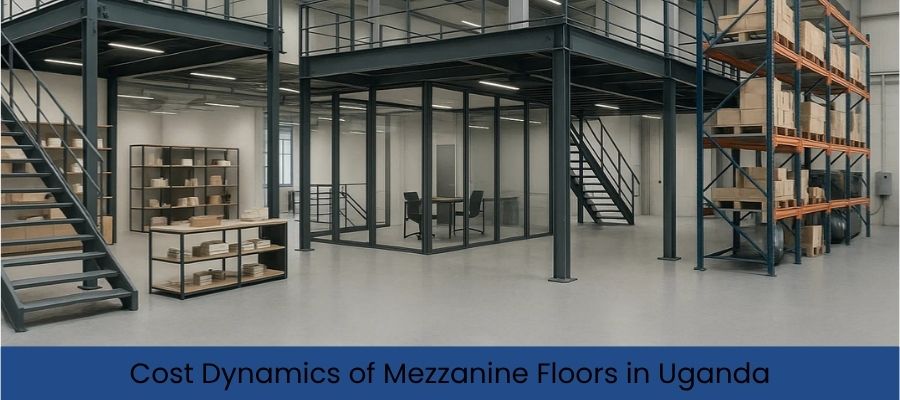The Rise of Mezzanine Floors in Uganda’s Warehousing and Logistics Boom

Objective:
This article aims to explore the increasing role of mezzanine structures in Uganda’s growing warehousing and logistics industry. It outlines the drivers behind this surge, the local applications and how these solutions are shaping the functional and spatial dynamics of warehousing infrastructure across Uganda.
Introduction
Over the past decade, Uganda has witnessed an unmistakable transformation in its logistics and warehousing sector. This shift is largely attributed to urban growth, a rise in consumer demand and increased regional trade activities. With space optimization becoming a core requirement in modern warehousing, mezzanine floors have emerged as a vital architectural feature. These semi-permanent, intermediate structures are increasingly found in warehouses, retail centers and industrial spaces throughout Uganda. Their strategic design allows businesses to maximize existing vertical space without undergoing full-scale construction or relocation. As a result, mezzanine platforms are becoming not just an option – but a necessary adaptation for Uganda’s warehouses aiming to remain efficient and competitive.
Uganda’s Warehousing Boom: An Overview
The growth in Uganda’s warehousing sector reflects a broader trend across East Africa. The capital city, Kampala and surrounding districts are seeing increased demand for logistics hubs. This is spurred by the development of regional trade corridors, infrastructural upgrades and the inflow of consumer goods. Traditional single-story warehouses no longer suffice. The pressure to manage inventory effectively within limited land spaces has led developers and facility managers to consider alternatives like industrial mezzanine floors to increase usable space without acquiring new land.
What Are Mezzanine Floors and Why Are They Gaining Ground in Uganda?
A mezzanine floor is an intermediate level constructed within a building to create additional floor space. Unlike permanent storeys, mezzanines are typically modular and customizable, making them ideal for retrofitting into existing warehouses. Their rising popularity in Uganda stems from their flexibility and cost-effectiveness. Given the high cost of acquiring or leasing new commercial land, many warehouse operators are choosing to install prefab mezzanine systems instead. These systems can be integrated quickly and scaled as needed.
Mezzanine Structures in Urban Warehouses
Urban centers in Uganda face the dual challenge of limited space and rising property prices. In this context, mezzanine structures provide a practical solution. Warehouses in areas like Namanve Industrial Park or the outskirts of Kampala now incorporate mezzanine platforms to store excess goods, create office partitions or support light industrial operations. The adaptability of mezzanine installations may allow these businesses to meet regulatory spacing requirements while still optimizing capacity.
Warehouse Mezzanine Applications Across Uganda
The applications of warehouse mezzanine systems in Uganda are diverse. While large-scale importers and distributors may use them for bulk storage, small-scale logistics operators can adopt them for sorting, assembly or administrative space. Depending on the load requirements, a mezzanine platform may support shelving units, workstations or conveyors. Their versatility fits the fragmented yet fast-growing logistics network in Uganda, where warehouses vary widely in design, scale and operational needs.
The Role of Prefab Mezzanine Systems
Prefab mezzanine systems offer an efficient alternative to traditional expansion methods. These pre-engineered solutions are designed for rapid installation and minimal disruption to ongoing operations. In Uganda, where many businesses operate under tight timelines and limited budgets, prefab systems can offer the speed and flexibility required for quick scale-up. They are particularly useful in rented or shared spaces where permanent modifications may not be permitted.
Material Trends in Ugandan Mezzanine Construction
The choice of materials used in mezzanine platforms in Uganda typically depends on application and budget. Steel remains the dominant material due to its strength and durability. However, timber-based mezzanines may be used for light storage or office partitions. Some suppliers offer composite systems that blend steel framing with wood decking. Given the regional climate, materials must be chosen for corrosion resistance and structural integrity over time.
Mezzanine Installation Standards and Considerations
Mezzanine installation in Uganda follows general engineering and safety protocols. Although there’s no centralized mezzanine regulation body in Uganda, installations must adhere to structural standards to ensure load-bearing capacity, fire safety and egress access. As businesses in Uganda adopt global warehousing standards, many are consulting structural engineers for customized designs that align with their operational workflows. Accessibility (via stairs or lifts) and adequate lighting are also critical components of functional mezzanine systems.

Cost Dynamics: Mezzanine Floor Cost in Uganda
The mezzanine floor cost in Uganda may vary significantly based on size, design complexity, materials and load requirements. While upfront costs may seem high, many warehouse owners view mezzanine systems as long-term investments that reduce the need for costly relocations or land purchases.
Factors Influencing Warehouse Mezzanine Cost
Several variables influence the warehouse mezzanine cost in Uganda:
- Material type: Steel vs timber or composite.
- Design: Custom vs standard modular designs.
- Installation complexity: Onsite adjustments, integration with equipment.
- Accessibility features: Stairs, lifts, safety rails.
- Load capacity requirements: Light vs heavy-duty usage.
Each project needs a tailored cost estimation. Hence, working with experienced mezzanine manufacturers or structural engineers can provide clarity during the budgeting phase.
Challenges in Mezzanine Integration in Uganda
Despite the benefits, integrating mezzanine structures in Uganda isn’t without challenges. Common obstacles include:
- Irregular building layouts.
- Structural limitations in older warehouses.
- Import delays of construction materials.
- Limited local expertise in modular mezzanine design.
However, with rising awareness and more skilled professionals entering the construction and warehousing sector, these challenges may be gradually mitigated.
Future Outlook: Mezzanine Platforms in Uganda’s Logistics Growth
As Uganda continues to position itself as a regional logistics hub, mezzanine platforms may become more integral to new warehouse builds and retrofits. The rise in e-commerce, FMCG distribution and agro-processing has intensified the need for efficient warehousing. Modular and scalable, mezzanine solutions align well with the dynamic nature of these industries. They may also support the transition to automation, offering platforms for conveyor belts, pick stations or even vertical lifts.
Conclusion:
The trajectory of Uganda’s warehousing and logistics boom underscores the growing need for space-efficient, adaptable infrastructure. In this context, mezzanine floors – whether in the form of prefab systems or custom-built structures – play a crucial role. Their integration may not only help businesses overcome spatial constraints but also pave the way for smarter, more agile warehouse operations. As urbanization accelerates and logistics demands intensify, mezzanine platforms are poised to become a permanent feature in Uganda’s industrial landscape.
FAQs Mezzanine Floors in Uganda
A mezzanine floor is a raised platform built between the floor and ceiling of a warehouse. It creates extra space for storage, offices or work areas without needing to expand the building.
The cost of a mezzanine floor in Uganda depends on size, materials and design. On average, basic steel mezzanine floors can start from around large area. Custom or heavy-duty designs may cost more.
Yes, mezzanine platforms can be added to most existing warehouses. They are modular and adjustable, making them suitable for spaces that need more room without major construction.
No, most mezzanine systems are semi-permanent. They can be removed, moved or reconfigured when needed, which makes them flexible for changing warehouse needs.
Yes, some manufacturers in Uganda provide mezzanine platforms. Others may use imported systems or combine local and imported materials based on the project.

Founder & CEO
Mukesh Patel is the Founder & CEO of Build Matt ltd, specializing in Pre-Engineered Buildings (PEB) and general steel fabrication. With advanced technology, modern machinery, and a skilled workforce, he delivers efficient and high-quality solutions across East and Central Africa, including Uganda, Kenya, Tanzania, Congo, South Sudan, Rwanda, and Burundi.
- CNC Plasma Cut Decorative Metal Panels: Revolutionizing Interior and Exterior Design
- Combining Roof Vents and Translucent Sheets for Better Airflow and Natural Lighting in Uganda Cities
- Top Design Trends in Steel Staircases for Modern Ugandan Buildings
- Steel Railings & Balustrades for Uganda Cities
- Modern Steel Silos & Hoppers : Transforming Grain Storage Efficiency in Uganda






